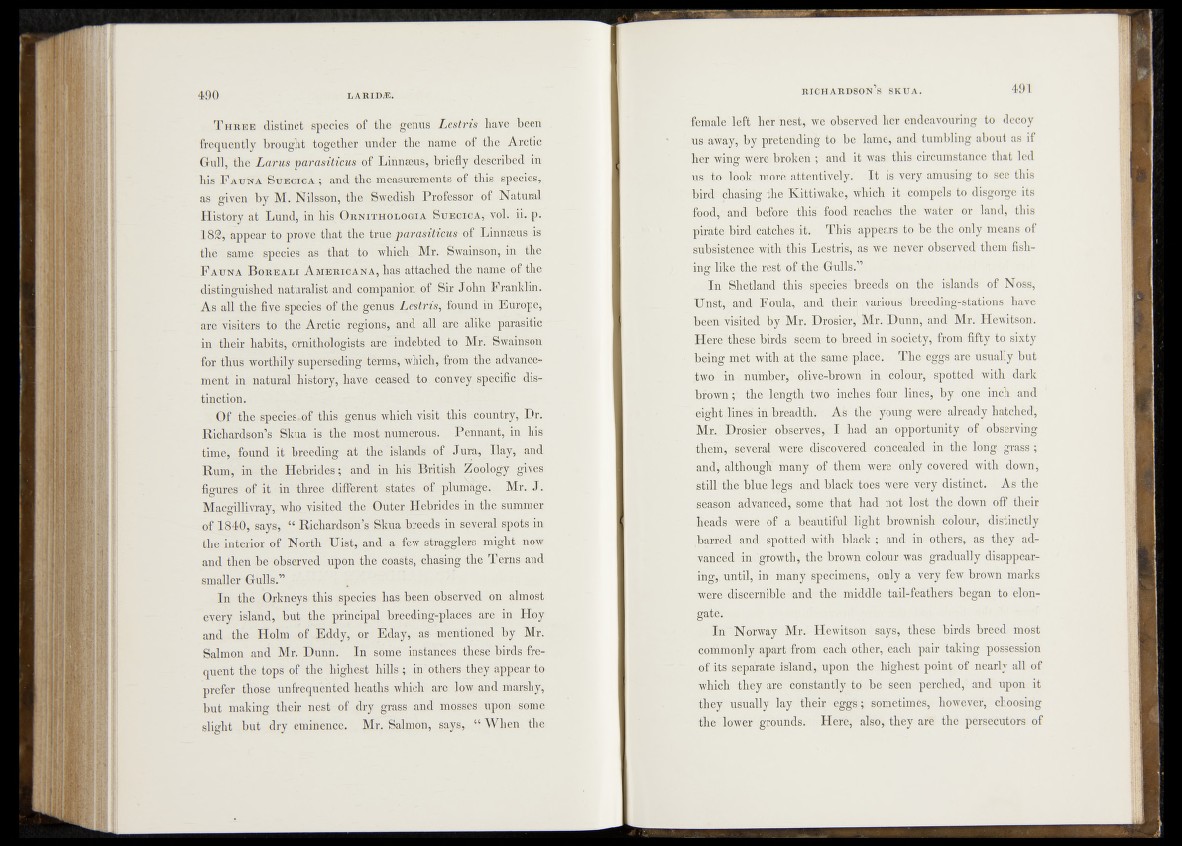
T hree distinct species of the genus Lestris have been
frequently brought together under the name of the Arctic
Gull, the Larus parasiticus of Linnaeus, briefly described in
his F auna Suecica ; and the measurements of this species,
as given by M. Nilsson, the Swedish Professor of Natural
History at Lund, in his O r n i t h o l o g ia Suecica,-vol. ii. p.
182, appear to prove that the true parasiticus of Linnaeus is
the same species as that to which Mr. Swaiilson, in the
F auna B oreali A mericana, has attached the name of the
distinguished naturalist and companion of Sir John Franklin.
As all the five species of the genus Lestris, found in Europe,
are visiters to the Arctic regions, and all are alike parasitic -
in their habits, ornithologists are indebted to Mr. Swainson
for thus worthily superseding terms, which, from the advancement
in natural history, have ceased to .convey specific distinction.
Of the species,of this genus which visit this country, Dr.
Richardson’s Skua is the most numerous. Pennant,-in n§s
time, found it breeding at the islands of Jura, Ilay, and
Rum, in the Hebrides ; and in his British Zoology gives
figures of it in three different states of plumage, Mr. J.
Macgillivray, who visited the Outer Hebrides in the summer
of 1840, says, “ Richardson’s Skua breeds in several spots in
the interior of North Uist, and a few stragglers might now
and then be observed upon the coasts, chasing the T eras and
smaller Gulls.”
In the Orkneys this species has been observed on almost
every island, but the principal breeding-places are in Hoy
and the Holm of Eddy, or Eday, as* -mentioned by Mr.
Salmon and Mr. Dunn. In some instances these birds frequent
the tops of the highest hills ; in'others they appear to
prefer those unfrequented heaths which are low and marshy,
but making their nest -of dry grass and mosses upon some
slight but dry eminence. Mr. Salmon, says, “ When the
female left her nest, we observed her endeavouring to decoy
us away, by pretending to be lame, and tumbling about as if
her wing were broken ; and it was this circumstance that led
us to look moré attentively. I t is very amusing to see this
bird chasing the Kittiwake, which it compels to disgorge its
food,r and before this food reaches the water or land, this
pirate bird catches it. This appears to be the only means of
subsistence with this Lestris, as we never observed them fishing
like the rest of the Gulls.”
In Shetland this species breeds on the islands of Noss,
Unst, and Foula, and their, various breeding-stations have
been visited by Mr. Drosier,'Mr. Dunn, and Mr. Hewitson.
Here these birds séem to breed in society, from fifty to sixty
being met with at the same place. - The eggs are usually but
two in number, olive-brown in colour, spotted with dark
brown ; the length two inches four lines, by one inch and
eight ;lines in breadth. As the -young were already hatched,
Mr. Drosier observes,..! had an opportunity of observing
them, several were discovered concealed in the long grass ;
and, although many of them were only covered with down,
still' the blue legs and black- toes were very distinct. As the
season advanced, some that had not lost the down off their
heads were of a .beautiful light brownish colour, distinctly
Jbarred and spotted with black ; and in others, as they advanced;
in growth, the brown colour was gradually disappearing,
until,.in many specimens, only a' very few brown marks
were discernible and the middle tail-feathers began to elongate.
In Norway Mr. Hewitson says, these, birds breed most
commonly apart from each other, ëach pair taking possession
of its separate island, upon the highest point of nearly all of
which they are constantly to be seen perched, and upon it
they usually lay their eggs; sometimes, however, choosing
the lower grounds. Here, also, they are the persecutors of